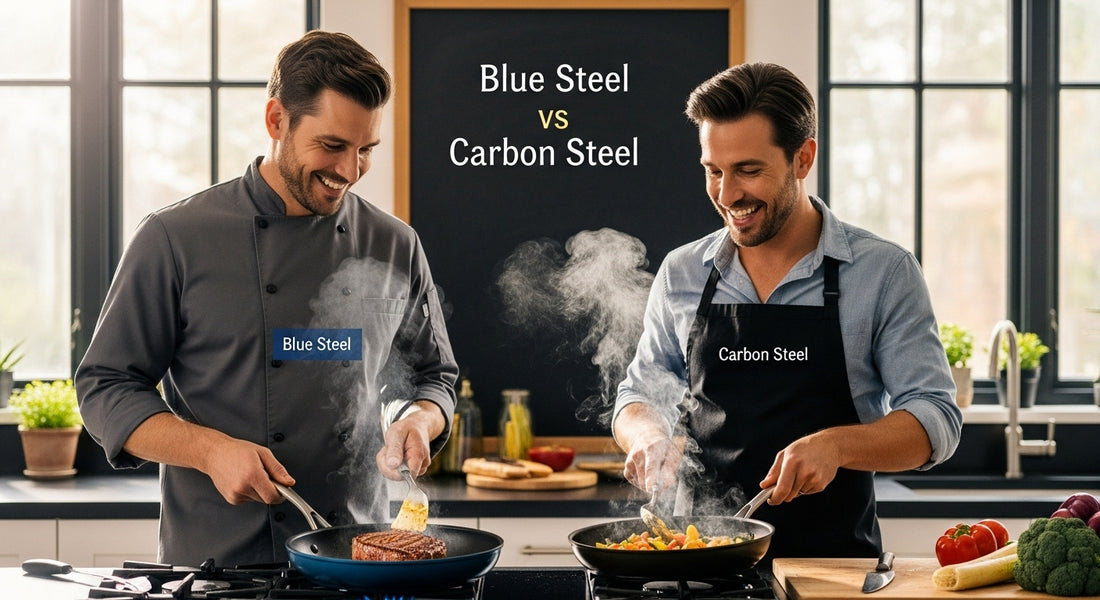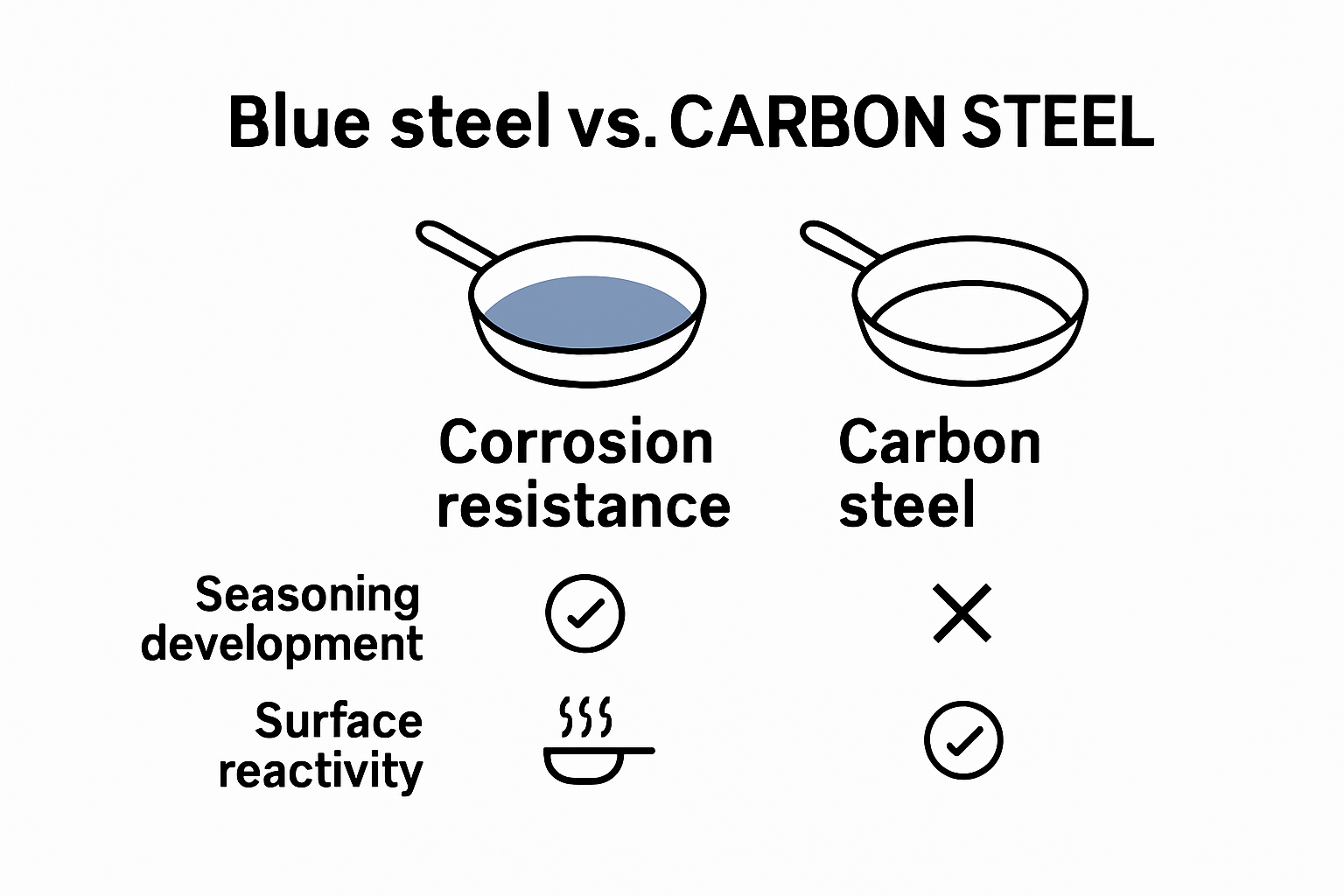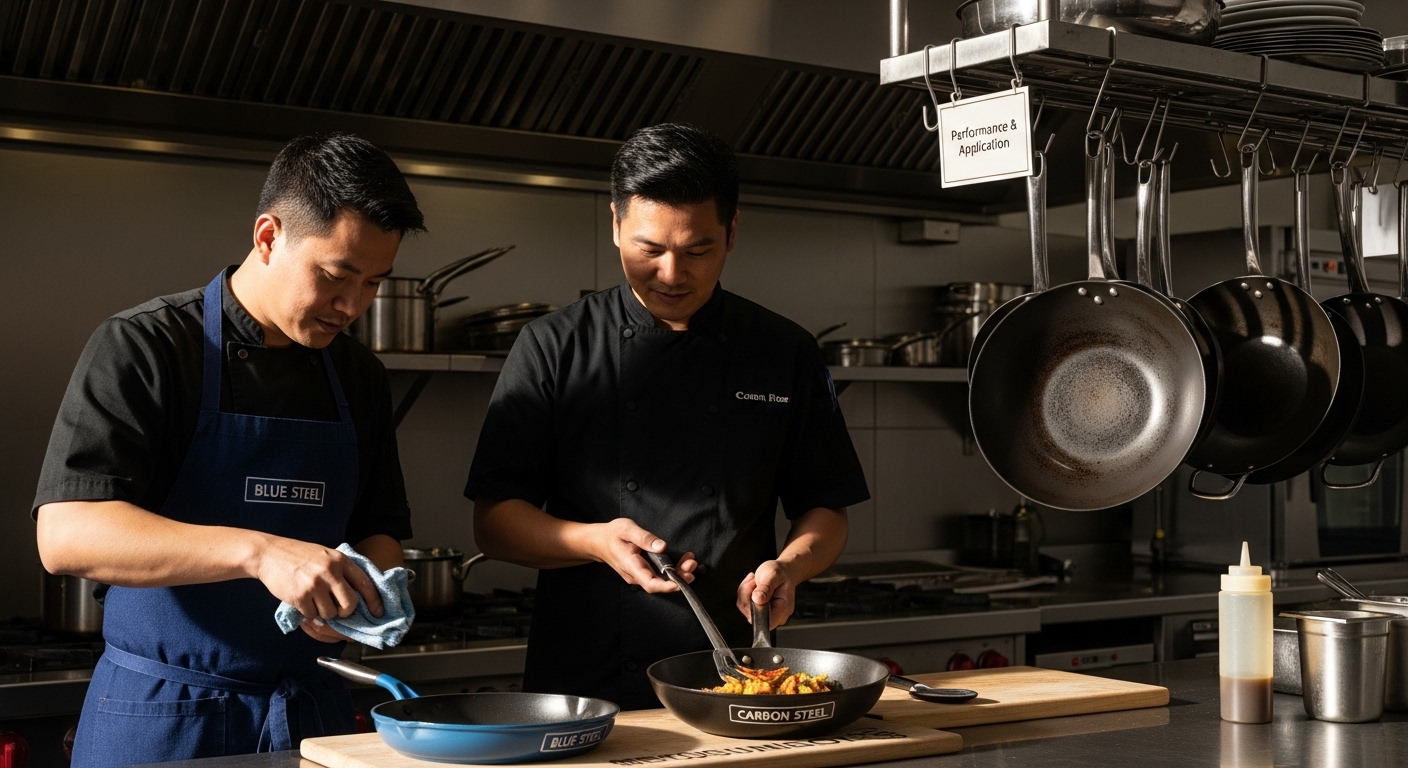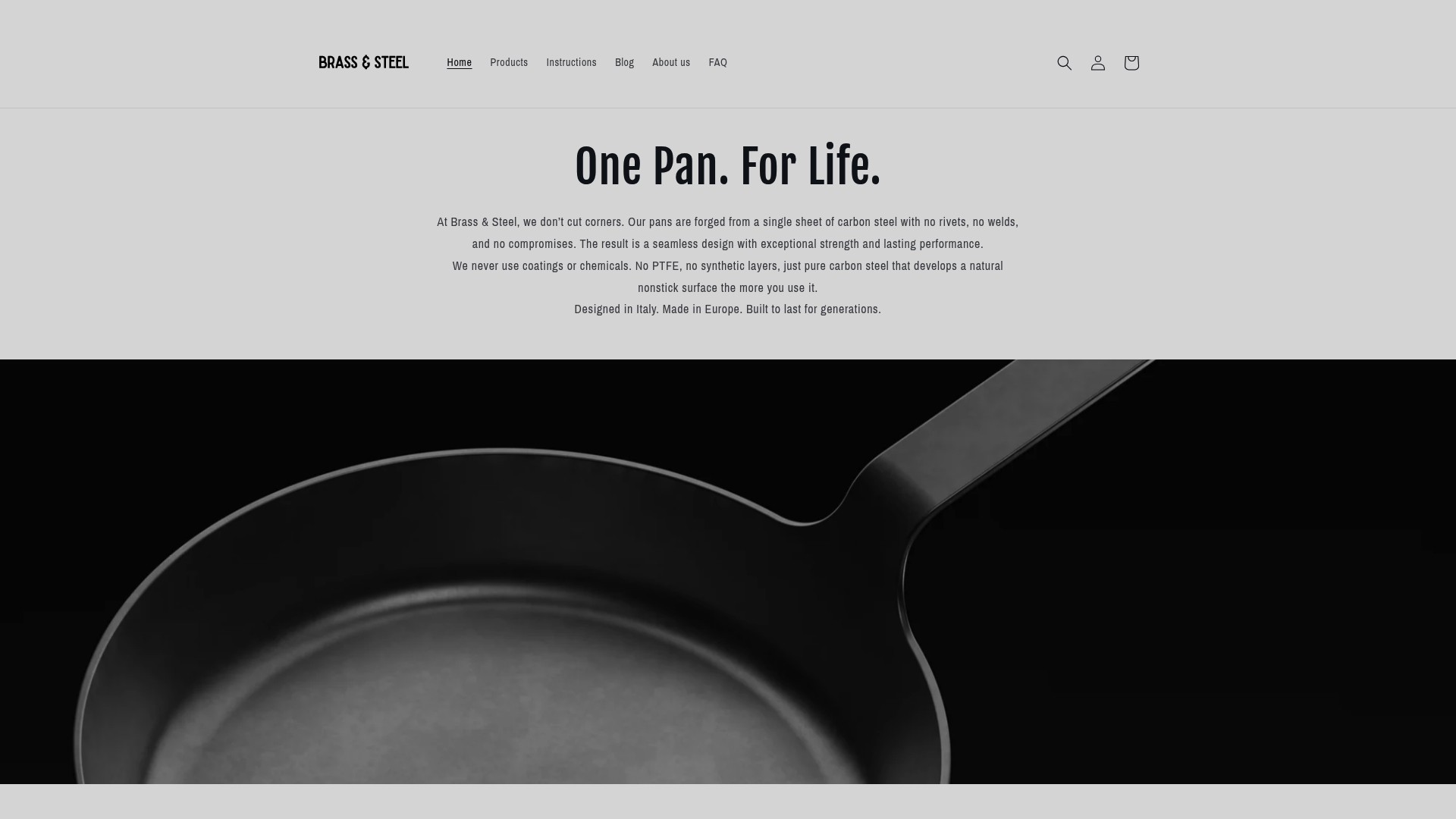
Understanding Blue Steel vs Carbon Steel for Cooking
Share
Choosing cookware might seem simple, but knowing the difference between blue steel and carbon steel could change everything you know about your kitchen. Most people assume all metal pans act more or less the same, maybe just with a different shine or a higher price tag. Yet, the real surprise is that blue steel can develop a stable non-stick surface much quicker and offers enhanced rust resistance thanks to its unique heat treatment. That subtle blue tint you see is actually doing far more than looking pretty.
Table of Contents
- Defining Blue Steel And Carbon Steel
- Importance Of Steel Selection In Cooking
- Properties That Differentiate Blue Steel From Carbon Steel
- Applications Of Blue Steel And Carbon Steel In Culinary Settings
- Choosing The Right Steel For Your Cooking Needs
Quick Summary
| Takeaway | Explanation |
|---|---|
| Blue steel offers enhanced corrosion resistance. | The unique manufacturing process of blue steel creates a surface that resists rust, making it more durable over time. |
| Carbon steel needs careful seasoning maintenance. | Carbon steel cookware requires more effort to develop a stable non-stick surface, especially when initially seasoning the metal. |
| Choose steel based on your cooking style. | Assess your cooking techniques, temperatures, and maintenance availability to select the right steel for optimal performance. |
| Both steels excel in heat distribution. | Both blue and carbon steel provide excellent heat conductivity, making them suitable for various cooking methods and ensuring even cooking results. |
| Understand reactivity for food safety. | Carbon steel pans can react with acidic foods, so proper seasoning is necessary to minimize potential flavour changes and health concerns. |
Defining Blue Steel and Carbon Steel
In the realm of professional cooking and cookware, understanding the nuanced differences between blue steel and carbon steel becomes crucial for selecting the right cooking equipment. These two metal types might seem similar at first glance, but they possess distinct characteristics that significantly impact their performance and usage.
Understanding Material Composition
Carbon steel is an alloy primarily composed of iron and carbon, typically containing between 0.05% to 2% carbon content. According to materials science research, carbon steel offers robust strength and superior heat distribution, making it a preferred choice for professional kitchen environments.
Blue steel, on the other hand, is a specific variant of carbon steel that undergoes a unique manufacturing process. During production, the steel is heated and cooled in a manner that creates a distinctive blue-tinted surface oxidation layer. This process not only provides aesthetic appeal but also contributes to enhanced corrosion resistance.
Key Characteristics for Cooking Applications
Both blue steel and carbon steel share fundamental properties that make them exceptional for culinary use:
- Excellent heat conductivity and even temperature distribution
- Ability to develop a natural non-stick patina through seasoning
- Durability and long-lasting performance
- Versatility across different cooking techniques
While carbon steel pans are widely used in professional kitchens, blue steel offers a slightly more refined aesthetic and marginally improved rust resistance. Read more about selecting the right carbon steel pan for your kitchen.
Understanding these materials helps chefs and cooking enthusiasts make informed decisions about their cookware, ensuring optimal performance and longevity in their culinary endeavours.
To clarify the main distinctions, the table below compares the key characteristics of blue steel and traditional carbon steel cookware for culinary applications.
| Feature | Carbon Steel | Blue Steel |
|---|---|---|
| Composition | Iron and carbon alloy | Iron and carbon alloy (with unique heat/oxidation treatment) |
| Surface Appearance | Silvery to dark grey | Distinctive blue tint |
| Corrosion Resistance | Prone to rust, requires careful maintenance | Enhanced rust resistance due to heat treatment |
| Seasoning Requirement | More effort and time to develop stable non-stick | Develops non-stick patina more quickly |
| Reactivity with Ingredients | Can react with acidic foods if unseasoned | Less initial reactivity, especially after seasoning |
| Aesthetic Appeal | Traditional industrial look | Slightly more refined, professional appearance |
| Maintenance Effort | Requires regular seasoning and drying | Easier retention of seasoning, less maintenance |
| Typical Applications | Searing, stir-frying, general use | Delicate proteins, professional applications needing consistency |
Importance of Steel Selection in Cooking
Selecting the appropriate steel type for cookware is not merely a technical decision but a critical factor that directly influences cooking performance, food quality, and overall culinary experience. Professional chefs and home cooks alike understand that the material of a cooking vessel can dramatically transform how ingredients interact with heat and ultimately impact the final dish.
Heat Management and Cooking Performance
The choice of steel significantly affects heat distribution, retention, and responsiveness. According to culinary research, carbon steel demonstrates remarkable durability and versatility in high-temperature cooking scenarios. Its ability to withstand intense heat while providing even temperature distribution makes it a preferred choice for techniques requiring precise thermal control.
Key performance factors in steel selection include:
- Thermal conductivity and heat distribution
- Weight and handling characteristics
- Durability and longevity
- Reactivity with different food types
- Maintenance requirements
Health and Safety Considerations
Beyond cooking performance, the steel type plays a crucial role in food safety and potential chemical interactions. Explore the health benefits of carbon steel cookware to understand how material selection impacts nutritional integrity and potential contaminant exposure.
Carbon steel, when properly seasoned, creates a natural non-stick surface without synthetic coatings, reducing potential chemical leaching during cooking. This makes it an attractive option for health-conscious individuals seeking cookware that minimises artificial interventions in food preparation.
Ultimately, understanding the nuanced characteristics of different steel types empowers cooks to make informed decisions that enhance culinary outcomes, protect health, and improve overall cooking enjoyment.
Properties That Differentiate Blue Steel from Carbon Steel
While blue steel and carbon steel share fundamental metallic characteristics, they exhibit nuanced differences that significantly impact their performance, durability, and culinary applications. Understanding these subtle variations becomes crucial for professionals and cooking enthusiasts seeking optimal cookware selection.
Manufacturing and Surface Treatment
According to metallurgical research, blue steel undergoes a distinctive annealing process that transforms its surface properties. This specialized heat treatment creates a harder, less reactive surface with a characteristic gunmetal blue or black appearance. The process not only enhances the steel’s structural integrity but also contributes to its unique aesthetic and functional qualities.
Key differences in manufacturing include:
- Surface oxidation level
- Heat treatment methodology
- Final surface texture and reactivity
- Corrosion resistance capabilities
- Potential for developing seasoning
Performance and Reactivity Characteristics
The manufacturing variations translate directly into performance distinctions.
 Blue steel typically demonstrates superior seasoning retention and reduced initial reactivity compared to standard carbon steel. This means blue steel cookware develops a more stable non-stick surface more rapidly and maintains its protective seasoning layer with greater consistency.
Blue steel typically demonstrates superior seasoning retention and reduced initial reactivity compared to standard carbon steel. This means blue steel cookware develops a more stable non-stick surface more rapidly and maintains its protective seasoning layer with greater consistency.
Compare carbon steel alternatives in our comprehensive guide, which explores the nuanced differences between various cookware materials.
Carbon steel, by contrast, remains more porous and requires more meticulous initial seasoning. Its higher reactivity means chefs must invest more time in developing and maintaining the cooking surface to prevent potential metallic interactions with acidic ingredients.
Ultimately, the choice between blue steel and carbon steel depends on individual cooking styles, maintenance preferences, and specific culinary requirements. Both materials offer exceptional heat conductivity and durability, with blue steel providing a marginally more refined and stable cooking surface.

Applications of Blue Steel and Carbon Steel in Culinary Settings
Professional chefs and passionate home cooks understand that selecting the right metal for cookware extends far beyond aesthetic preferences. Blue steel and carbon steel each offer distinctive characteristics that make them invaluable in specific culinary contexts, transforming cooking techniques and ingredient preparation.
Professional Kitchen Versatility
According to culinary research, carbon steel demonstrates remarkable adaptability across various cooking methods. Its robust heat distribution and responsiveness make it particularly suited for techniques requiring precise temperature control and rapid thermal transitions.
Key culinary applications include:
- High temperature searing
- Rapid stir frying
- Creating delicate crepes and omelettes
- Developing complex caramelization
- Producing consistent restaurant quality results
Specialized Cooking Techniques
Blue steel, with its refined surface treatment, excels in scenarios demanding minimal reactivity and superior seasoning retention. Professional kitchens frequently utilise blue steel for delicate protein preparations and techniques requiring nuanced heat management.
Explore comprehensive comparisons between different cookware materials to understand the subtle yet significant differences in performance.
While carbon steel remains more porous and requires meticulous maintenance, blue steel offers a marginally more stable cooking surface. This makes blue steel particularly attractive for chefs seeking consistency in high-performance cooking environments where minimal surface interaction with ingredients is paramount.
Ultimately, both blue steel and carbon steel represent sophisticated choices for culinary professionals who demand exceptional heat control, durability, and cooking precision.
Choosing the Right Steel for Your Cooking Needs
Selecting the optimal steel for cookware requires a nuanced understanding of individual cooking styles, maintenance capabilities, and specific culinary objectives. While blue steel and carbon steel share fundamental metallic characteristics, their subtle differences can significantly impact cooking performance and long term kitchen satisfaction.
Assessing Personal Cooking Requirements
Research indicates that understanding your specific cooking techniques is paramount when selecting steel cookware. Serious home cooks and professional chefs must consider multiple factors beyond mere aesthetic preferences.
Key considerations for steel selection include:
- Frequency of high temperature cooking
- Complexity of cooking techniques performed
- Maintenance time available
- Budget constraints
- Desired cooking surface characteristics
Performance Matching and Skill Level
Blue steel typically suits experienced cooks who understand precise seasoning techniques and require minimal surface reactivity. Its refined manufacturing process creates a more stable cooking surface that demands less initial maintenance compared to standard carbon steel.
Learn more about navigating cookware choices to make an informed decision tailored to your specific culinary needs.
Carbon steel, conversely, offers greater versatility for intermediate cooks willing to invest time in developing and maintaining their cookware. Its more porous surface allows for more robust seasoning development, making it an excellent training ground for understanding metallic cookware interactions.
Ultimately, the choice between blue steel and carbon steel transcends technical specifications. It represents a personal commitment to culinary craft, reflecting an individual’s cooking philosophy, skill level, and dedication to mastering their kitchen tools.
The following table summarises the key factors to consider when selecting between blue steel and carbon steel cookware, based on personal needs and skill levels.
| Consideration | Blue Steel | Carbon Steel |
|---|---|---|
| Suitable Skill Level | More suitable for experienced cooks | Good for both intermediate and advanced |
| Maintenance Requirements | Lower, retains seasoning longer | Higher, more frequent seasoning needed |
| Surface Stability | More rapidly develops and maintains non-stick | Requires more maintenance to stabilise |
| Heat Conductivity | Excellent, suitable for precision cooking | Excellent, with robust versatility |
| Budget Suitability | Typically mid-range to premium | Broader range available |
| Preferred Cooking Techniques | Delicate preparations, consistency in results | Searing, stir-frying, general use |
| Time Investment in Upkeep | Reduced | Increased |
Discover the Perfect Carbon Steel Cookware for Your Culinary Ambitions
If you have just learned the subtle differences between blue steel and carbon steel, you may be searching for a dependable solution that promises both performance and longevity. Many cooks struggle to find a pan that delivers reliable heat, develops a natural nonstick patina, and stands up to every kitchen challenge. This is precisely where our Carbon Steel Collection comes in. Our single-piece, high-quality carbon steel cookware is engineered for chefs who refuse to compromise on results or durability.

Elevate your cooking with the peace of mind that comes from choosing a pan designed for professional results. Experience the difference of forged carbon steel—crafted without rivets, made for induction, and engineered for a lifetime of use. Explore our range now on https://brass-steel.com and secure the tool that will help you master every recipe. Whether you are seeking your first seasoned pan or looking to upgrade, our collection of carbon steel pans is ready to help you transform technique into tradition. Shop today and step into a new era of confident cooking.
Frequently Asked Questions
What is the difference between blue steel and carbon steel?
Blue steel is a variant of carbon steel that undergoes a unique manufacturing process, resulting in a distinctive blue-tinted surface that offers enhanced corrosion resistance. Carbon steel is primarily composed of iron and carbon, providing excellent heat distribution and strength.
How do I maintain blue steel and carbon steel cookware?
Both blue steel and carbon steel require seasoning to develop a natural non-stick surface. Regular cleaning and proper drying are important to prevent rust. Blue steel typically requires less initial maintenance and retains its seasoning better than standard carbon steel.
Can blue steel and carbon steel pans be used for high-temperature cooking?
Yes, both blue steel and carbon steel pans excel in high-temperature cooking scenarios. They offer excellent heat conductivity, making them ideal for techniques such as searing, stir-frying, and creating delicate dishes like crepes and omelettes.
Are there any health benefits to using carbon steel cookware?
Carbon steel, when properly seasoned, provides a natural non-stick surface without synthetic coatings, reducing the risk of chemical leaching during cooking. This makes it a safer choice for health-conscious individuals seeking to minimise artificial interventions in their food preparation.
Recommended
- Carbon Steel vs Stainless Steel Pans, which one is best? – Brass & Steel
- Is a Carbon Steel Pan the Right Choice for You? – Brass & Steel
- Carbon Steel or Enameled Cast Iron? – Brass & Steel
- Health & Safety Benefits of Carbon Steel Pans – Brass & Steel
- Carbon Steel Properties for Gauteng Industries 2025 - Genesis Steel